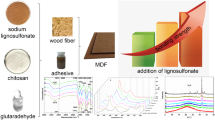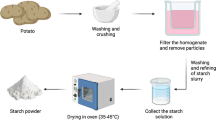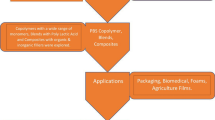Abstract
In this work, composites were prepared in polyurethane (PU) matrices with sawdust fibers at levels of 10, 20 and 30%. The PU was obtained using polyols, castor oil and wood tar pitch (bio-pitch), reacted with a polymeric 4,4′-diphenylmethane diisocyanate (MDI), in a ratio NCO/OH = 1:1, catalyzed by dibutyltin dilaurate. Two groups of composites were formulated: materials synthesized only with polyol castor oil (PU 0%), and those obtained with 25% bio-pitch and 75% castor oil (PU 25%). The sawdust fibers were previously modified by mercerization, followed by benzylation or reaction with toluene diisocyanate (TDI). The changes were confirmed by infrared spectroscopy (FTIR), scanning electron microscopy (SEM), thermogravimetry (TG), X-ray diffraction and X-ray photoelectron spectroscopy (XPS). The addition of bio-pitch to the matrix caused an increase in its porosity and a decrease in density. The sawdust showed good adhesion to the matrix containing bio-pitch, which was confirmed by the increase in the mechanical properties of its composites. The water absorption results showed that the matrix composites containing bio-pitch are more hydrophobic, with greater intercrossing, which corroborates the evaluation of good fiber–matrix interaction. Vegetable pitch seems to behave as a coupling agent between the fiber and the matrix, presenting itself as a suitable polyol for the synthesis of composites from renewable sources.













Similar content being viewed by others
References
Papageorgiou GZ (2018) Thinking green: sustainable polymers from renewable resources. Polymers 10:952. https://doi.org/10.3390/polym10090952
Mohanty AK, Misra M, Drzal LT (2002) Sustainable bio-composites from renewable resources: opportunities and challenges in the green materials world. J Polym Environ 10:19–26. https://doi.org/10.1023/A:1021013921916
Biermann U, Bornscheuer U, Meier MAR, Metzger JO, Schafer HJ (2011) Oils and fats as renewable raw materials in chemistry. Angew Chem Ind 50:3854–3871. https://doi.org/10.1002/anie.201002767
Melo BN, Pasa VMD (2003) Composites based on eucalyptus tar pitch/castor oil polyurethane and short sisal fibers. J Appl Polym Sci 89:3797–3802. https://doi.org/10.1002/app.12424
Costa RRC, Sato ES, Ribeiro ML, Medeiros R, Vieira AFC, Guedes RM, Tita V (2020) Polyurethane derived from castor oil reinforced with long cotton fibers: Static and dynamic testing of a novel eco-friendly composite material. J Compos Mater 54(22):3125–3142. https://doi.org/10.1177/0021998320911984
Das A, Mahanwar P (2020) A brief discussion on advances in polyurethane applications. Adv Ind Eng Polym Res 3:93–101. https://doi.org/10.1016/j.aiepr.2020.07.002
Somarathna HMCC, Raman SN, Mohotti D, Mutalib AA, Badri KH (2018) The use of polyurethane for structural and infrastructural engineering applications: a state-of-the-art review. Const Build Mater 190:995–1014. https://doi.org/10.1016/j.conbuildmat.2018.09.166)
Zhang J, Yao M, Chen J, Jiang Z, Ma Y (2019) Synthesis and properties of polyurethane elastomers based on renewable castor oil polyols. J Appl Polym Sci 136:47309. https://doi.org/10.1002/APP.47309
Coman AE, Peyrton J, Hubca G, Sarbu A, Gabor AR, Nicolae CA, Iordache TV, Averous L (2021) Synthesis and characterization of renewable polyurethane foams using different biobased polyols from olive oil. Eur Polym J 149:110363. https://doi.org/10.1016/j.eurpolymj.2021.110363
Ma Y, **ao Y, Zhao Y, Bei Y, Hu L, Zhou Y, Jia P (2022) Biomass based polyols and biomass based polyurethane materials as a route towards sustainability. React Funct Polym 175:105285. https://doi.org/10.1016/j.reactfunctpolym.2022.105285
Gurunathana T, Arukula R (2018) High performance polyurethane dispersion synthesized from plant oil renewable resources: a challenge in the green materials. Polym Degrad Stab 150:122–213. https://doi.org/10.1016/j.polymdegradstab.2018.02.014
Sawpan MA (2018) Polyurethanes from vegetable oils and applications: a review. J Polym Res 25:184. https://doi.org/10.1007/s10965-018-1578-3
Członka S, Kerche EF, Neves RM, Strkowska A, Strzelec K (2021) Bio-based rigid polyurethane foam composites reinforced with bleached curauá fiber. Int J Mol Sci 22:11203. https://doi.org/10.3390/ijms222011203
Ellenberger A, Polli ML, Azevedo E, de Paula CRP (2013) Drilling of natural fiber-reinforced based polyurethane foam composite. J App Polym Sci. 129:2224–2233. https://doi.org/10.1177/00219983211059581
Melo BN, Santos CG, Botaro VR, Pasa VMD (2008) Eco-composites of polyurethane and Luffa aegyptiaca modified by mercerisation and benzylation. Polym Polym Compos 16(4):249. https://doi.org/10.1177/096739110801600404
Silvia A (1983) Mamona–Potencialidades Agroindustriais do Nordeste Brasileiro. Recife: SUDENE–ADR, p 154
Park CK, Lee JH, Kim IS, Kim SH (2020) Castor oil-based polyols with gradually increasing functionalities for biopolyurethane synthesis. J App Polym Sci 137:48304. https://doi.org/10.1002/app.48304
Villar WD (1993) Química e tecnologia dos poliuretanos. In: Rio de Janeiro (eds) Pronor
Sultan M, Jamal Z, Jubeen F, Farooq A, Bibi I, Uroos M, Chaudhry H, Alissa SA, Iqbal M (2021) Green synthesis of biodegradable polyurethane and castor oil-based composite for benign transformation of methylene blue. Arab J Chem 14:103417. https://doi.org/10.1016/j.arabjc.2021.103417
Tavares LB, Boas CV, Schleder GR, Nacas AM, Rosa DS, Santos DJ (2016) Biobased polyurethane prepared from based kraft lignin and modified castor oil. Express Polym Lett 10:927–940
Ionescu M, Radojcic D, Wan X, Shrestha ML, Petrovic ZS, Upshaw TA (2016) Highly functional polyols from castor oil for rigid polyurethanes. Eur Polym J 84:736–749. https://doi.org/10.1016/j.eurpolymj.2016.06.006
Melo BN, Pasa VMD, Martins MD, Macedo WAA, Muniz EP (2018) Strengthening of a polyurethane matrix by luffa cylindrica treated with TDI: water absorption and mechanical properties. J Polym Environ 26:2514–2521
Araújo RCS, Pasa VMD, Melo BN (2005) Effects of biopitch on the properties of flexible polyurethane foams. Eur Polym J 41(6):1420–1428. https://doi.org/10.1016/j.eurpolymj.2004.12.021
Araújo RCS, Pasa VMD (2004) New eucalyptus tar-derived polyurethane coatings. Prog Org Coat 51(1):6–14. https://doi.org/10.1016/j.porgcoat.2004.04.002
Melo BN, Pasa VMD (2003) Composites based on eucalyptus tar pitch/castor oil polyurethane and short sisal fibers. J App Polym Sci 89(14):3797–3802. https://doi.org/10.1002/app.12424
Prauchner MJ, Pasa VMD, Otani S, Otani C (2005) Biopitch-based general purpose carbon fibers: processing and properties. Carbon 43:591–597. https://doi.org/10.1016/j.carbon.2004.10.023
Prauchner MJ, Pasa VMD, Otani C, Otani S (2001) Characterization and thermal polymerization of eucalyptus tar pitches. Energy Fuels 15:449–454. https://doi.org/10.1021/ef000196o
Prauchner MJ, Pasa VMD, Otani C, OtanI S (2004) The use of DSC to assess the stabilization of thermoplastic eucalyptus tar pitch fibers. J Therm Anal Cal 76:935–940. https://doi.org/10.1023/B:JTAN.0000032278.06131.69
Melo BN, Pasa VMD (2004) Thermal and morphological study of polyurethanes based on EUCALYPTUS tar pich and castor oil. J App Polym Sci 92:3287–3291. https://doi.org/10.1002/app.20278
Tiuca AE, Nemeş O, Vermeşana H, Tomab AC (2019) New sound absorbent composite materials based on sawdust and polyurethane foam. Compos Part B Eng 165:120–130. https://doi.org/10.1016/j.compositesb.2018.11.103
Namrata VP, Muhammad MR, Rahman AN (2019) “Green” composites using bioresins from agro-wastesand modified sisal fibers. Polym Compos 40:99–108. https://doi.org/10.1002/pc.24607
Głowinska E, Datta J, Parcheta P (2017) Effect of sisal fiber filler on thermal properties of bio-based polyurethane composites. J Therm Anal Calorim 130:113–122. https://doi.org/10.1007/s10973-017-6293-5
Li M, Pu Y, Thomas VM, Yoo CG, Ozcan S, Deng Y, Nelson K, Ragauskas AJ (2020) Recent advancements of plant-based natural fiber–reinforced composites and their applications. Compos B 200:108254. https://doi.org/10.1016/j.compositesb.2020.108254
Hassan MZ, Roslan SA, Sapuan SM, Rasid ZA, Mohd Nor AF, Md Daud MY, Dolah R, Yusof MZM (2020) Mercerization optimization off bamboo (Bambusa vulgaris) fiber-feinforced epoxy composite structures using a box-behnken design. Polymers 12:1367. https://doi.org/10.3390/polym12061367
Cai M, Takagi H, Nakagaito AN, Li Y, Waterhouse GIN (2016) Effect of alkali treatment on interfacial bonding in abaca fiber-reinforced composites. Compos Part A App Sci Manuf 90:589–597. https://doi.org/10.1016/j.compositesa.2016.08.025
Vardhini KJV, Murugan R, Selvi CT, Surjit R (2016) Optimisation of alkali treatment of banana fibres on lignin removal. Indian J Fibre Text Res 41:156–160
Segal L, Creely JJ, Martin AE, Conrad CM (1959) An empirical method for estimating the degree of crystallinity of native cellulose using the X-ray diffractometer. Text Res J 29:786–794. https://doi.org/10.1177/004051755902901003
Joseph K, Thomas S, Pavithran C (1996) Effect of chemical treatment on the tensile properties of sisal fiber-reinforced polyethylene composites. Polymer 37:5139–5149. https://doi.org/10.1016/0032-3861(96)00144-9
Spiridon L, Anghel N, Bele A (2015) The behaviour of biodegradable composites on starch reinforced with modified cellulosic fibers. Polym Adv Technol 26:1189–1197. https://doi.org/10.1002/pat.3553
Ferreira FC, Curvelo AAS, Mattoso LHC (2003) Preparation and characterization of benzylated sisal fibers. J App Polym Sci 89:2957–2965. https://doi.org/10.1002/app.12409
Deslandes Y, Pleizier G, Alexander D, Santerre P (1998) XPS and SIMS characterisation of segmented polyether polyurethanes containing two different soft segments. Polymer 39:2361–2366. https://doi.org/10.1016/S0032-3861(97)00533-8
McBurney LF (1954) Kinetics of degradation reactions. In: Ott E, Spurlin HM, Grafflin MW (eds) Cellulose and cellulose derivatives, vol 1, 2nd edn. Interscience, New York, pp 99–167
Dominguez-rosado E, Liggat JJ, Snape CE, Eling B, Pichtel J (2002) Thermal degradation of urethane modified polyisocyanurate foams based on aliphatic and aromatic polyester polyol. Polym Degrad Stab 78:1–5. https://doi.org/10.1016/S0141-3910(02)00086-1
Martins MCL, Wang D, Ji J, Feng L, Barbosa MA (2003) Albumin and Fibrinogen Adsorption on PU-PHEMA surfaces. Biomaterials 24:2067–2076. https://doi.org/10.1016/S0142-9612(03)00002-4
Bawn C (1987) Surface analysis. In: Mark HF, Bikales N, Over-berger CG, Menges G (eds) Encyclopedia of polymer science and engineering: JI Kroschwitz, vol 16. Wiley, New York, p 400
Sreekala MS, kumaran MG, Thomas S (2002) Water sorption in oil palm fiber reinforced phenol formaldehyde composites. Compos Part A Appl Sci Manuf 33:736–777. https://doi.org/10.1016/S1359-835X(02)00032-5
Daniel IM, Ishai O (1994) Engineering mechanics of composite materials, 1st edn. Oxford University Press, New York
Joly C, Gauthier R, Escoubes M (1996) Partial masking of cellulosic hydrophilicity for composite applications. Water sorption by chemically modified fibers. J Appl Polym Sci 61:57–69. https://doi.org/10.1002/(SICI)1097-4628(19960705)61:1%3c57::AID-APP7%3e3.0.CO;2-T
Acknowledgements
This work was carried out through scientific cooperation with the Federal University of Minas Gerais and the analysis carried out at the Laboratory of Applied Physics of the CDTN to whom I would like to thank.
Funding
Benzylation ensured a lower water absorption to the composites generated with 20% and 30% of these fibers due to the benzene rings exposed on the fiber surface.
Author information
Authors and Affiliations
Corresponding author
Ethics declarations
Conflict of interest
The authors declare that they have no known competing financial interests or personal relationships that could have appeared to influence the work reported in this paper.
Additional information
Publisher's Note
Springer Nature remains neutral with regard to jurisdictional claims in published maps and institutional affiliations.
Rights and permissions
Springer Nature or its licensor (e.g. a society or other partner) holds exclusive rights to this article under a publishing agreement with the author(s) or other rightsholder(s); author self-archiving of the accepted manuscript version of this article is solely governed by the terms of such publishing agreement and applicable law.
About this article
Cite this article
de Melo, B.N., Pasa, V.M.D., Martins, M.D. et al. Effect of functionalizing sawdust as a reinforcement in two types of renewable polyurethane. Polym. Bull. 81, 3107–3126 (2024). https://doi.org/10.1007/s00289-023-04833-2
Received:
Revised:
Accepted:
Published:
Issue Date:
DOI: https://doi.org/10.1007/s00289-023-04833-2




